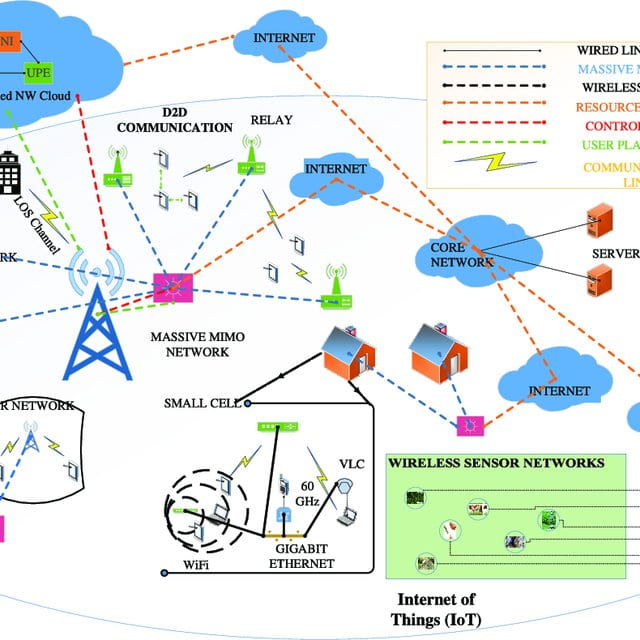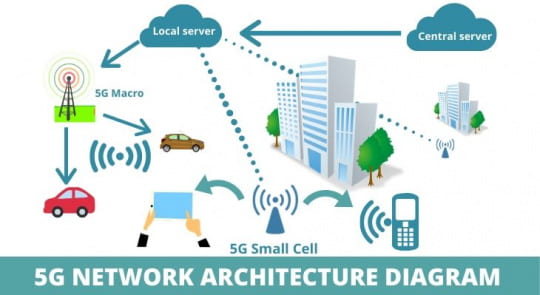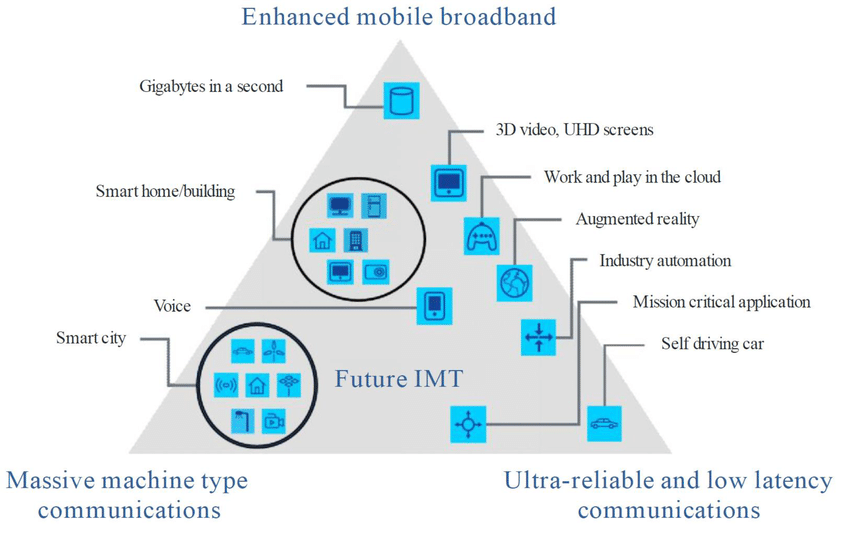Definition
Before understanding the concept of 5G, let’s first understand its development process: 1G to 4G.
①1G:Applied to mobile phones, it can only be used to make calls.
②2G:Applied to mobile phones with screen display function,can send message.
③3G:Applied to mobile phones with big screen,realize multimedia communication other than voice communication, such as browsing simple websites, you can see pictures.
④4G:Applied to smart mobile phones,you can watch videos.
1G~4G are all focusing on more convenient and faster communication between people, and the existence of 5G will realize the interconnection of everything at anytime, anywhere, and let human beings dare to expect to participate in it synchronously with all things on the earth through live broadcast.
5G, in fact, is the fifth-generation mobile communication technology, which firstly increases the download speed extremely. Judging from the current situation, 5G networks have begun to be commercialized. Due to the rapid development of the Internet of Things, especially the Internet of automobiles and other industries, it has higher requirements for network speed. The emergence of 5G has undoubtedly become an important factor in promoting the development of the Internet of Things.
 Overview
Overview
In telecommunications, 5G is the fifth generation technology standard for cellular networks, which cellular phone companies began deploying worldwide in 2019, the planned successor to the 4G networks which provide connectivity to most current cellphones. Like its predecessors, 5G networks are cellular networks, in which the service area is divided into small geographical areas called cells. All 5G wireless devices in a cell are connected to the Internet and telephone network by radio waves through a local antenna in the cell. The main advantage of the new networks is that they will have greater bandwidth, giving higher download speeds,[1] eventually up to 10 gigabits per second (Gbit/s). Due to the increased bandwidth, it is expected that the new networks will not just serve cellphones like existing cellular networks, but also be used as general internet service providers for laptops and desktop computers, competing with existing ISPs such as cable internet, and also will make possible new applications in internet of things (IoT) and machine to machine areas. Current 4G cellphones will not be able to use the new networks, which will require new 5G enabled wireless devices.
The increased speed is achieved partly by using higher-frequency radio waves than current cellular networks. However, higher-frequency radio waves have a shorter range than the frequencies used by previous cell phone towers, requiring smaller cells. So, to ensure wide service, 5G networks operate on up to three frequency bands, low, medium, and high. A 5G network will be composed of networks of up to 3 different types of cells, each requiring different antennas, each type giving a different tradeoff of download speed vs. distance and service area. 5G cellphones and wireless devices will connect to the network through the highest speed antenna within range at their location:
Low-band 5G uses a similar frequency range to current 4G cellphones, 600-700 MHz, giving download speeds a little higher than 4G: 30-250 megabits per second (Mbit/s). Low-band cell towers will have a range and coverage area similar to current 4G towers. Mid-band 5G uses microwaves of 2.5-3.7 GHz, currently allowing speeds of 100-900 Mbit/s, with each cell tower providing service up to several miles in radius. This level of service is the most widely deployed, and should be available in most metropolitan areas in 2020. Some countries are not implementing low-band, making this the minimum service level. High-band 5G currently uses frequencies of 25-39 GHz, near the bottom of the millimeter wave band, although higher frequencies may be used in the future. It often achieves download speeds of a gigabit per second (Gbit/s), comparable to cable internet. However, millimeter waves (mm Wave or mmW) have a more limited range, requiring many small cells. They have trouble passing through some types of walls and windows. Due to their higher costs, current plans are to deploy these cells only in dense urban environments and areas where crowds of people congregate such as sports stadiums and convention centers. The above speeds are those achieved in actual tests in 2020, and speeds are expected to increase during rollout.
The industry consortium setting standards for 5G is the 3rd Generation Partnership Project (3GPP). It defines any system using 5G NR (5G New Radio) software as “5G”, a definition that came into general use by late 2018. Minimum standards are set by the International Telecommunications Union (ITU). Previously, some reserved the term 5G for systems that deliver download speeds of 20 Gbit/s as specified in the ITU’s IMT-2020 document.
 Application areas
Application areas
The ITU-R has defined three main application areas for the enhanced capabilities of 5G. They are Enhanced Mobile Broadband (eMBB), Ultra Reliable Low Latency Communications (URLLC), and Massive Machine Type Communications (mMTC). Only eMBB is deployed in 2020; URLLC and mMTC are several years away in most locations.
Enhanced Mobile Broadband (eMBB) uses 5G as a progression from 4G LTE mobile broadband services, with faster connections, higher throughput, and more capacity.
Ultra-Reliable Low-Latency Communications (URLLC) refer to using the network for mission critical applications that require uninterrupted and robust data exchange.
Massive Machine-Type Communications (mMTC) would be used to connect to a large number of devices. 5G technology will connect some of the 50 billion connected IoT devices. Most will use the less expensive Wi-Fi. Drones, transmitting via 4G or 5G, will aid in disaster recovery efforts, providing real-time data for emergency responders. Most cars will have a 4G or 5G cellular connection for many services. Autonomous cars do not require 5G, as they have to be able to operate where they do not have a network connection. While remote surgeries have been performed over 5G, most remote surgery will be performed in facilities with a fiber connection, usually faster and more reliable than any wireless connection.
 Speed
Speed
5G speeds will range from ~50 Mbit/s to over a gigabit/s. The fastest 5G is known as mmWave. As of July 3, 2019, mmWave had a top speed of 1.8 Gbit/s on AT&T’s 5G network.
Sub-6 GHz 5G (mid-band 5G), by far the most common, will usually deliver between 100 and 400 Mbit/s, but will have a much farther reach than mmWave, especially outdoors.
Low-band spectrum offers the farthest area coverage but is slower than the others.
5G NR speed in sub-6 GHz bands can be slightly higher than the 4G with a similar amount of spectrum and antennas, although some 3GPP 5G networks will be slower than some advanced 4G networks, such as T-Mobile’s LTE/LAA network, which achieves 500+ Mbit/s in Manhattan and Chicago. The 5G specification allows LAA (License Assisted Access) as well, but LAA in 5G has not yet been demonstrated. Adding LAA to an existing 4G configuration can add hundreds of megabits per second to the speed, but this is an extension of 4G, not a new part of the 5G standard.
The similarity in terms of throughput between 4G and 5G in the existing bands is because 4G already approaches the Shannon limit on data communication rates. 5G speeds in the less common millimeter wave spectrum, with its much more abundant bandwidth and shorter range, and hence greater frequency reusability, can be substantially higher.
Risk
We Have No Reason to Believe 5G Is Safe. The technology is coming, but contrary to what some people say, there could be health risks.
The telecommunications industry and their experts have accused many scientists who have researched the effects of cell phone radiation of “fear mongering” over the advent of wireless technology’s 5G. Since much of our research is publicly-funded, we believe it is our ethical responsibility to inform the public about what the peer-reviewed scientific literature tells us about the health risks from wireless radiation.
The chairman of the Federal Communications Commission (FCC) recently announced through a press release that the commission will soon reaffirm the radio frequency radiation (RFR) exposure limits that the FCC adopted in the late 1990s. These limits are based upon a behavioral change in rats exposed to microwave radiation and were designed to protect us from short-term heating risks due to RFR exposure.
Yet, since the FCC adopted these limits based largely on research from the 1980s, the preponderance of peer-reviewed research, more than 500 studies, have found harmful biologic or health effects from exposure to RFR at intensities too low to cause significant heating.
Citing this large body of research, more than 240 scientists who have published peer-reviewed research on the biologic and health effects of nonionizing electromagnetic fields (EMF) signed the International EMF Scientist Appeal, which calls for stronger exposure limits. The appeal makes the following assertions:
“Numerous recent scientific publications have shown that EMF affects living organisms at levels well below most international and national guidelines. Effects include increased cancer risk, cellular stress, increase in harmful free radicals, genetic damages, structural and functional changes of the reproductive system, learning and memory deficits, neurological disorders, and negative impacts on general well-being in humans. Damage goes well beyond the human race, as there is growing evidence of harmful effects to both plant and animal life.”
The scientists who signed this appeal arguably constitute the majority of experts on the effects of nonionizing radiation. They have published more than 2,000 papers and letters on EMF in professional journals.
The FCC’s RFR exposure limits regulate the intensity of exposure, taking into account the frequency of the carrier waves, but ignore the signaling properties of the RFR. Along with the patterning and duration of exposures, certain characteristics of the signal (e.g., pulsing, polarization) increase the biologic and health impacts of the exposure. New exposure limits are needed which account for these differential effects. Moreover, these limits should be based on a biological effect, not a change in a laboratory rat’s behavior.
The World Health Organization’s International Agency for Research on Cancer (IARC) classified RFR as “possibly carcinogenic to humans” in 2011. Last year, a $30 million study conducted by the U.S. National Toxicology Program (NTP) found “clear evidence” that two years of exposure to cell phone RFR increased cancer in male rats and damaged DNA in rats and mice of both sexes. The Ramazzini Institute in Italy replicated the key finding of the NTP using a different carrier frequency and much weaker exposure to cell phone radiation over the life of the rats.
Based upon the research published since 2011, including human and animal studies and mechanistic data, the IARC has recently prioritized RFR to be reviewed again in the next five years. Since many EMF scientists believe we now have sufficient evidence to consider RFR as either a probable or known human carcinogen, the IARC will likely upgrade the carcinogenic potential of RFR in the near future.
Nonetheless, without conducting a formal risk assessment or a systematic review of the research on RFR health effects, the FDA recently reaffirmed the FCC’s 1996 exposure limits in a letter to the FCC, stating that the agency had “concluded that no changes to the current standards are warranted at this time,” and that “NTP’s experimental findings should not be applied to human cell phone usage.” The letter stated that “the available scientific evidence to date does not support adverse health effects in humans due to exposures at or under the current limits.”
The latest cellular technology, 5G, will employ millimeter waves for the first time in addition to microwaves that have been in use for older cellular technologies, 2G through 4G. Given limited reach, 5G will require cell antennas every 100 to 200 meters, exposing many people to millimeter wave radiation. 5G also employs new technologies (e.g., active antennas capable of beam-forming; phased arrays; massive multiple inputs and outputs, known as massive MIMO) which pose unique challenges for measuring exposures.
Millimeter waves are mostly absorbed within a few millimeters of human skin and in the surface layers of the cornea. Short-term exposure can have adverse physiological effects in the peripheral nervous system, the immune system and the cardiovascular system. The research suggests that long-term exposure may pose health risks to the skin (e.g., melanoma), the eyes (e.g., ocular melanoma) and the testes (e.g., sterility).
Since 5G is a new technology, there is no research on health effects, so we are “flying blind” to quote a U.S. senator. However, we have considerable evidence about the harmful effects of 2G and 3G. Little is known the effects of exposure to 4G, a 10-year-old technology, because governments have been remiss in funding this research. Meanwhile, we are seeing increases in certain types of head and neck tumors in tumor registries, which may be at least partially attributable to the proliferation of cell phone radiation. These increases are consistent with results from case-control studies of tumor risk in heavy cell phone users.
5G will not replace 4G; it will accompany 4G for the near future and possibly over the long term. If there are synergistic effects from simultaneous exposures to multiple types of RFR, our overall risk of harm from RFR may increase substantially. Cancer is not the only risk as there is considerable evidence that RFR causes neurological disorders and reproductive harm, likely due to oxidative stress.
As a society, should we invest hundreds of billions of dollars deploying 5G, a cellular technology that requires the installation of 800,000 or more new cell antenna sites in the U.S. close to where we live, work and play?
Instead, we should support the recommendations of the 250 scientists and medical doctors who signed the 5G Appeal that calls for an immediate moratorium on the deployment of 5G and demand that our government fund the research needed to adopt biologically based exposure limits that protect our health and safety.
(Reference by Joel M. Moskowitz on October 17, 2019)
